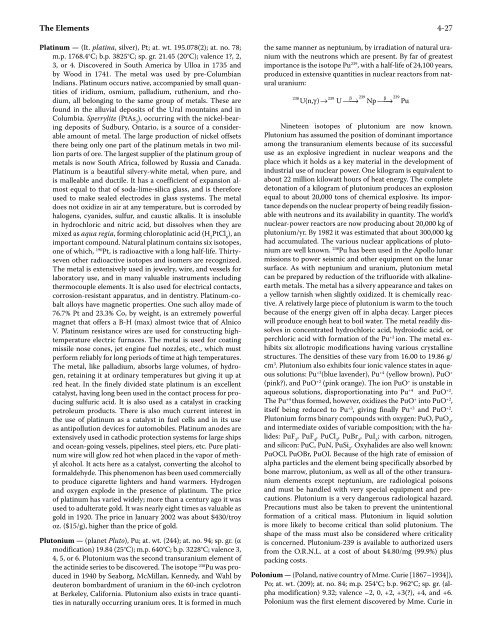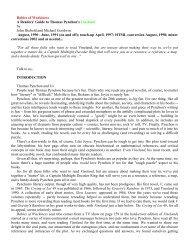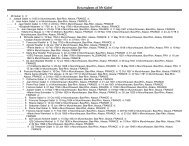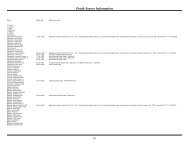CRC Handbook of Chemistry and Physics, 86th Edition
CRC Handbook of Chemistry and Physics, 86th Edition
CRC Handbook of Chemistry and Physics, 86th Edition
Create successful ePaper yourself
Turn your PDF publications into a flip-book with our unique Google optimized e-Paper software.
The Elements 4-27<br />
Platinum — (It. platina, silver), Pt; at. wt. 195.078(2); at. no. 78;<br />
m.p. 1768.4°C; b.p. 3825°C; sp. gr. 21.45 (20°C); valence 1?, 2,<br />
3, or 4. Discovered in South America by Ulloa in 1735 <strong>and</strong><br />
by Wood in 1741. The metal was used by pre-Columbian<br />
Indians. Platinum occurs native, accompanied by small quantities<br />
<strong>of</strong> iridium, osmium, palladium, ruthenium, <strong>and</strong> rhodium,<br />
all belonging to the same group <strong>of</strong> metals. These are<br />
found in the alluvial deposits <strong>of</strong> the Ural mountains <strong>and</strong> in<br />
Columbia. Sperrylite (PtAs 2 ), occurring with the nickel-bearing<br />
deposits <strong>of</strong> Sudbury, Ontario, is a source <strong>of</strong> a considerable<br />
amount <strong>of</strong> metal. The large production <strong>of</strong> nickel <strong>of</strong>fsets<br />
there being only one part <strong>of</strong> the platinum metals in two million<br />
parts <strong>of</strong> ore. The largest supplier <strong>of</strong> the platinum group <strong>of</strong><br />
metals is now South Africa, followed by Russia <strong>and</strong> Canada.<br />
Platinum is a beautiful silvery-white metal, when pure, <strong>and</strong><br />
is malleable <strong>and</strong> ductile. It has a coefficient <strong>of</strong> expansion almost<br />
equal to that <strong>of</strong> soda-lime-silica glass, <strong>and</strong> is therefore<br />
used to make sealed electrodes in glass systems. The metal<br />
does not oxidize in air at any temperature, but is corroded by<br />
halogens, cyanides, sulfur, <strong>and</strong> caustic alkalis. It is insoluble<br />
in hydrochloric <strong>and</strong> nitric acid, but dissolves when they are<br />
mixed as aqua regia, forming chloroplatinic acid (H 2 PtCl 6 ), an<br />
important compound. Natural platinum contains six isotopes,<br />
one <strong>of</strong> which, 190 Pt, is radioactive with a long half-life. Thirtyseven<br />
other radioactive isotopes <strong>and</strong> isomers are recognized.<br />
The metal is extensively used in jewelry, wire, <strong>and</strong> vessels for<br />
laboratory use, <strong>and</strong> in many valuable instruments including<br />
thermocouple elements. It is also used for electrical contacts,<br />
corrosion-resistant apparatus, <strong>and</strong> in dentistry. Platinum-cobalt<br />
alloys have magnetic properties. One such alloy made <strong>of</strong><br />
76.7% Pt <strong>and</strong> 23.3% Co, by weight, is an extremely powerful<br />
magnet that <strong>of</strong>fers a B-H (max) almost twice that <strong>of</strong> Alnico<br />
V. Platinum resistance wires are used for constructing hightemperature<br />
electric furnaces. The metal is used for coating<br />
missile nose cones, jet engine fuel nozzles, etc., which must<br />
perform reliably for long periods <strong>of</strong> time at high temperatures.<br />
The metal, like palladium, absorbs large volumes, <strong>of</strong> hydrogen,<br />
retaining it at ordinary temperatures but giving it up at<br />
red heat. In the finely divided state platinum is an excellent<br />
catalyst, having long been used in the contact process for producing<br />
sulfuric acid. It is also used as a catalyst in cracking<br />
petroleum products. There is also much current interest in<br />
the use <strong>of</strong> platinum as a catalyst in fuel cells <strong>and</strong> in its use<br />
as antipollution devices for automobiles. Platinum anodes are<br />
extensively used in cathodic protection systems for large ships<br />
<strong>and</strong> ocean-going vessels, pipelines, steel piers, etc. Pure platinum<br />
wire will glow red hot when placed in the vapor <strong>of</strong> methyl<br />
alcohol. It acts here as a catalyst, converting the alcohol to<br />
formaldehyde. This phenomenon has been used commercially<br />
to produce cigarette lighters <strong>and</strong> h<strong>and</strong> warmers. Hydrogen<br />
<strong>and</strong> oxygen explode in the presence <strong>of</strong> platinum. The price<br />
<strong>of</strong> platinum has varied widely; more than a century ago it was<br />
used to adulterate gold. It was nearly eight times as valuable as<br />
gold in 1920. The price in January 2002 was about $430/troy<br />
oz. ($15/g), higher than the price <strong>of</strong> gold.<br />
Plutonium — (planet Pluto), Pu; at. wt. (244); at. no. 94; sp. gr. (α<br />
modification) 19.84 (25°C); m.p. 640°C; b.p. 3228°C; valence 3,<br />
4, 5, or 6. Plutonium was the second transuranium element <strong>of</strong><br />
the actinide series to be discovered. The isotope 238 Pu was produced<br />
in 1940 by Seaborg, McMillan, Kennedy, <strong>and</strong> Wahl by<br />
deuteron bombardment <strong>of</strong> uranium in the 60-inch cyclotron<br />
at Berkeley, California. Plutonium also exists in trace quantities<br />
in naturally occurring uranium ores. It is formed in much<br />
the same manner as neptunium, by irradiation <strong>of</strong> natural uranium<br />
with the neutrons which are present. By far <strong>of</strong> greatest<br />
importance is the isotope Pu 239 , with a half-life <strong>of</strong> 24,100 years,<br />
produced in extensive quantities in nuclear reactors from natural<br />
uranium:<br />
U(n, γ)<br />
→ U ⎯→⎯ Np ⎯→⎯ Pu<br />
238 239 β 239 β 239<br />
Nineteen isotopes <strong>of</strong> plutonium are now known.<br />
Plutonium has assumed the position <strong>of</strong> dominant importance<br />
among the transuranium elements because <strong>of</strong> its successful<br />
use as an explosive ingredient in nuclear weapons <strong>and</strong> the<br />
place which it holds as a key material in the development <strong>of</strong><br />
industrial use <strong>of</strong> nuclear power. One kilogram is equivalent to<br />
about 22 million kilowatt hours <strong>of</strong> heat energy. The complete<br />
detonation <strong>of</strong> a kilogram <strong>of</strong> plutonium produces an explosion<br />
equal to about 20,000 tons <strong>of</strong> chemical explosive. Its importance<br />
depends on the nuclear property <strong>of</strong> being readily fissionable<br />
with neutrons <strong>and</strong> its availability in quantity. The world’s<br />
nuclear-power reactors are now producing about 20,000 kg <strong>of</strong><br />
plutonium/yr. By 1982 it was estimated that about 300,000 kg<br />
had accumulated. The various nuclear applications <strong>of</strong> plutonium<br />
are well known. 238 Pu has been used in the Apollo lunar<br />
missions to power seismic <strong>and</strong> other equipment on the lunar<br />
surface. As with neptunium <strong>and</strong> uranium, plutonium metal<br />
can be prepared by reduction <strong>of</strong> the trifluoride with alkalineearth<br />
metals. The metal has a silvery appearance <strong>and</strong> takes on<br />
a yellow tarnish when slightly oxidized. It is chemically reactive.<br />
A relatively large piece <strong>of</strong> plutonium is warm to the touch<br />
because <strong>of</strong> the energy given <strong>of</strong>f in alpha decay. Larger pieces<br />
will produce enough heat to boil water. The metal readily dissolves<br />
in concentrated hydrochloric acid, hydroiodic acid, or<br />
perchloric acid with formation <strong>of</strong> the Pu +3 ion. The metal exhibits<br />
six allotropic modifications having various crystalline<br />
structures. The densities <strong>of</strong> these vary from 16.00 to 19.86 g/<br />
cm 3 . Plutonium also exhibits four ionic valence states in aqueous<br />
solutions: Pu +3 (blue lavender), Pu +4 (yellow brown), PuO +<br />
(pink?), <strong>and</strong> PuO +2 (pink orange). The ion PuO + is unstable in<br />
aqueous solutions, disproportionating into Pu +4 <strong>and</strong> PuO +2 .<br />
The Pu +4 thus formed, however, oxidizes the PuO + into PuO +2 ,<br />
itself being reduced to Pu +3 , giving finally Pu +3 <strong>and</strong> PuO +2 .<br />
Plutonium forms binary compounds with oxygen: PuO, PuO 2 ,<br />
<strong>and</strong> intermediate oxides <strong>of</strong> variable composition; with the halides:<br />
PuF 3 , PuF 4 , PuCl 3 , PuBr 3 , PuI 3 ; with carbon, nitrogen,<br />
<strong>and</strong> silicon: PuC, PuN, PuSi 2 . Oxyhalides are also well known:<br />
PuOCl, PuOBr, PuOI. Because <strong>of</strong> the high rate <strong>of</strong> emission <strong>of</strong><br />
alpha particles <strong>and</strong> the element being specifically absorbed by<br />
bone marrow, plutonium, as well as all <strong>of</strong> the other transuranium<br />
elements except neptunium, are radiological poisons<br />
<strong>and</strong> must be h<strong>and</strong>led with very special equipment <strong>and</strong> precautions.<br />
Plutonium is a very dangerous radiological hazard.<br />
Precautions must also be taken to prevent the unintentional<br />
formation <strong>of</strong> a critical mass. Plutonium in liquid solution<br />
is more likely to become critical than solid plutonium. The<br />
shape <strong>of</strong> the mass must also be considered where criticality<br />
is concerned. Plutonium-239 is available to authorized users<br />
from the O.R.N.L. at a cost <strong>of</strong> about $4.80/mg (99.9%) plus<br />
packing costs.<br />
Polonium — (Pol<strong>and</strong>, native country <strong>of</strong> Mme. Curie [1867–1934]),<br />
Po; at. wt. (209); at. no. 84; m.p. 254°C; b.p. 962°C; sp. gr. (alpha<br />
modification) 9.32; valence –2, 0, +2, +3(?), +4, <strong>and</strong> +6.<br />
Polonium was the first element discovered by Mme. Curie in







